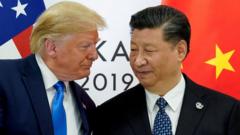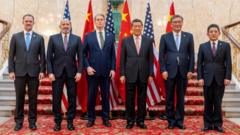President Trump has raised tariffs on foreign steel and aluminum to 50%, a doubling of the previous 25% rate, citing national security concerns and the need to protect U.S. manufacturers. This move has drawn criticism from allied countries and industry stakeholders reliant on these metals, with hopes of bolstering American production coming at a potential cost to sectors such as automotive and construction that depend on imported materials.
# Increased Tariffs on Foreign Steel and Aluminum Set to Impact U.S. Economy

# Increased Tariffs on Foreign Steel and Aluminum Set to Impact U.S. Economy
The U.S. government has enacted significant tariff increases on steel and aluminum imports, causing concerns among global trading partners and various domestic industries.
Higher tariffs on foreign metals took effect earlier today, with President Trump announcing an increase to 50 percent from 25 percent in a bid to protect the U.S. steel and aluminum industries. The White House justified the dramatic tariff hike by claiming it addresses "trade practices that undermine national security," aligning it with efforts to revive domestic manufacturing.
During a recent visit to a U.S. Steel facility, Trump emphasized the need for these tariffs, claiming they will help American producers fend off low-cost imports primarily from countries like China. This increase is part of a broader policy aimed at supporting American jobs and retaining competitiveness against foreign producers deemed responsible for oversaturating the market.
The tariffs, however, have sparked outrage among key trading partners, notably Canada and Europe, whose businesses now face heightened costs when exporting to the U.S. Additionally, industries heavily reliant on imported steel and aluminum, such as automotive, aerospace, construction, and energy, are sounding the alarm over potential supply chain disruptions and increased project costs.
Industry groups have generally welcomed the tariff changes. Kevin Dempsey, president of the American Iron and Steel Institute, noted that these import tariffs are essential to protect U.S. producers from unfair competition and surplus products flooding the market. The anticipated outcome is a stabilization in U.S. steel and aluminum pricing, fostering a stronger domestic industry amid challenging global trading conditions.
The ramifications of these new tariffs are multifaceted. While designed to bolster American manufacturing, they come with the potential to exacerbate tensions with allied nations and disrupt U.S. manufacturers that depend on global supply chains. As the situation develops, the balance between promoting local production and maintaining favorable international trade relations will be crucial for policymakers and stakeholders across the spectrum.
During a recent visit to a U.S. Steel facility, Trump emphasized the need for these tariffs, claiming they will help American producers fend off low-cost imports primarily from countries like China. This increase is part of a broader policy aimed at supporting American jobs and retaining competitiveness against foreign producers deemed responsible for oversaturating the market.
The tariffs, however, have sparked outrage among key trading partners, notably Canada and Europe, whose businesses now face heightened costs when exporting to the U.S. Additionally, industries heavily reliant on imported steel and aluminum, such as automotive, aerospace, construction, and energy, are sounding the alarm over potential supply chain disruptions and increased project costs.
Industry groups have generally welcomed the tariff changes. Kevin Dempsey, president of the American Iron and Steel Institute, noted that these import tariffs are essential to protect U.S. producers from unfair competition and surplus products flooding the market. The anticipated outcome is a stabilization in U.S. steel and aluminum pricing, fostering a stronger domestic industry amid challenging global trading conditions.
The ramifications of these new tariffs are multifaceted. While designed to bolster American manufacturing, they come with the potential to exacerbate tensions with allied nations and disrupt U.S. manufacturers that depend on global supply chains. As the situation develops, the balance between promoting local production and maintaining favorable international trade relations will be crucial for policymakers and stakeholders across the spectrum.






















